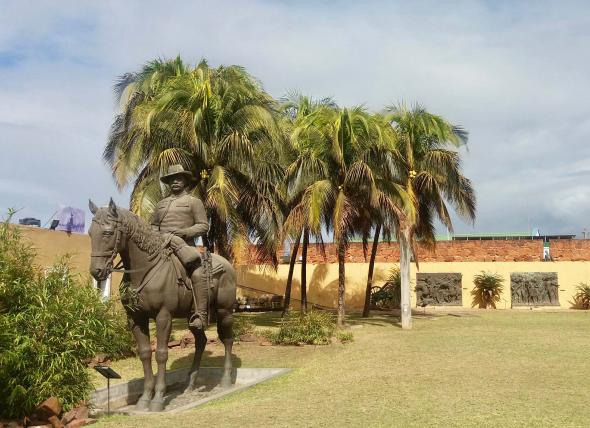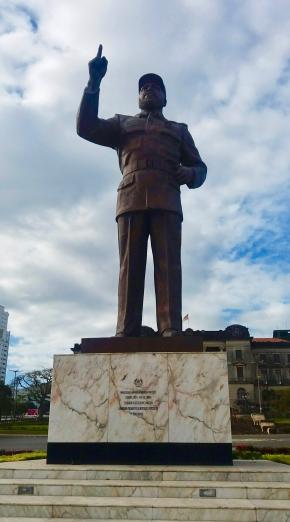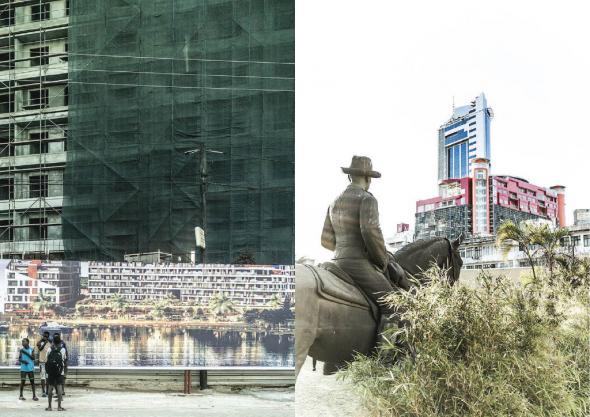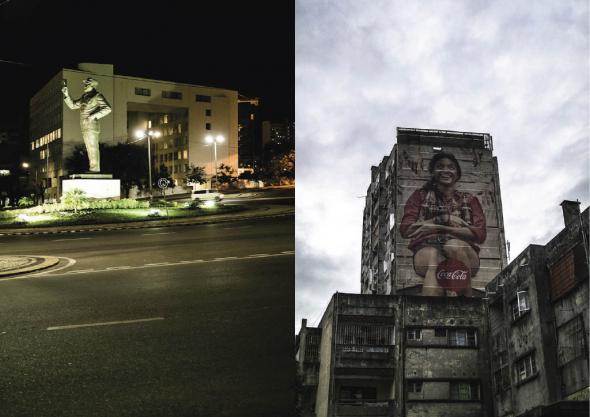Writing with bodies: installing a new history of Mozambique from Maputo Fortress
Located in the oldest part of Maputo, capital of Mozambique, the Fortress of Our Lady of the Conception, or simply Maputo Fortress, was built by Portuguese in 1780s on the ruins of previous fortifications built by Dutch and Austrians. Although French corsairs conquered and burned it down at the end of 18th century, the Portuguese reconquered the fortress, rebuilding it many times. The current building dates back to 1940s1. Deprived of its original functions, the old fortress is now the Museum of Military History.
 Maputo Fortress, Maputo (photo Roberto Conduru)
Maputo Fortress, Maputo (photo Roberto Conduru)
However, who visits Maputo Fortress today finds more than objects and narratives about the military actions in the region. Besides that, one can find old artifacts and monuments’ fragments, as well as exhibitions related to history, culture and art. More than a museum, the fortress deserves the classification it received in 2002 as a Mozambican Cultural Heritage Monument. It is really a complex historical site, since the building, the museum, its collections and exhibitions are connected to other monuments and urban spaces throughout Mozambique territory, disseminating a particular interpretation of history in that region. Reviewing this installation of multimedia artifacts, this text analyzes how a somewhat involuntary articulation of objects, artworks, exhibitions, architecture, cities and territory connects Maputo Fortress to processes of cultural decolonization and political disputes.
As we approach the fort and enter it, the bronze sculpture of a man riding a horse grows in our field of vision. It represents the Portuguese cavalry officer Joaquim Augusto Mouzinho de Albuquerque, who in 1895, imprisoned Ngungunyane, king of the Empire of Gaza, who was challenging the colonial rule established after the partition of Africa in late nineteenth century. The Portuguese colonizers sent the former king first to Lisbon and later to the islands of Terceira, in the Portuguese Azores, where he lived in exile until his death in 1906. The officer governed Mozambique between 1896 and 1898.
Mouzinho de Albuquerque’s bronze sculpture was part of the monument built to him in a square with his name at the center of Lourenço Marques, the colony’s capital which was later renamed as Maputo. As Gerbert Verheij wrote, the monument erected in 1940 is part of the large production of public sculpture for the former colonies by the Portuguese Estado Novo regime aiming at “building a ‘collective memory,’ creating appropriate spaces for political worship and staging a social order.”2 As Verheij also observed, “the monument was, thus, to be part of the new ‘civic axis’ with monumental intentions, a new public space which would mark the city’s imaginary, centralizing the main local government and religious buildings.”3 Articulated to smaller and standardized monuments in Languene, Chaimite and Macontene, historical sites of Mouzinho de Albuquerque’s itinerary in his military campaigns of 1895 and 18974, the monument in Maputo structured the physical and cultural landscape of the capital and the southern region of Mozambique.
Not by chance, the sentence “Portugal é aqui” (Portugal is here) was inscribed in the pavement between the monument and the Town Hall, reaffirming colonizer’s understanding of Mozambique as an extension of Portuguese territory. Indeed, the monument and the inscription on the ground were ways of making explicit, from the urban space of Maputo, the plurisecular Portuguese colonial project, which was reaffirmed at the Exposição Colonial Portuguesa (Portuguese Colonial Exhibition), held in Porto in 1934, when the map Portugal não é um país pequeno (Portugal is not a small country) was published; imperialist action that was again celebrated at the Exposição do Mundo Português (Portuguese World Exhibition), held in Lisbon in 1940.
The independence of Mozambique in 1975 changed the destiny of Mouzinho de Albuquerque’s monument. That same year, before the independence, it was dismantled. While the statue and the bas-reliefs were transferred to Maputo’s Fortress, other parts disappeared without trace. A 1910 statue of António José Enes, High Commissioner in Mozambique from 1891, was also transferred to the same historical site. What suggests an official policy concerning colonial monuments, which were preserved to keep the memory of old times.
After independence, Mouzinho de Albuquerque square was renamed as Independence square. The sculptured homage to Mouzinho de Albuquerque was replaced by a gigantic monument to Samora Machel, the first president of the Republic of Mozambique. This substitution did not happen immediately, but only in 2011, thirty-six years after Mozambique’s independence and twenty-five years after his death. However, the homage to Machel was not restricted to the capital, extending throughout the country. According to a government decision of the same year, Independence squares were to be set up in all provincial capitals and to receive identical but smaller statues produced in North Korea by Mansudae Art Studio: the statue erected in the capital is 9 meters high, while those implanted in other cities are 2.9 meters high. Structured from Maputo, this homogeneous and hierarchical set of squares and statues constitute the new “civic axis” of the independent Mozambican territory, replacing the “civic axis” of colonial Mozambique, which from Lourenço Marques reached only its southern region.
Although there are controversies regarding the similarity of the bronze figures with the national independence hero, the image of Machel resonates throughout the country. Meanwhile, Mouzinho de Albuquerque’s and Enes’ statues are circumscribed to Maputo’s Fortress. Even if Mouzinho de Albuquerque’s statue preserves some prominence due to its location near the center of the courtyard, while Enes’ one is located next to a side of the fortification, both of them have lost almost totally their previous monumentality, since they were deprived of their plinths and installed directly on the ground – in reality, Mouzinho de Albuquerque’s statue is strangely semi-buried, due to its installation a few centimeters below the ground level. Previously, these statues were the main elements of monuments dedicated to those two colonizers. Now, they are important components, although not the main ones, of a bigger ensemble that affirms the independence of Mozambique and publicly rewrites its history.
In a text published December 2018 on the Buala website, Vítor de Sousa analyzes how the dismantling of the monument of Mouzinho de Albuquerque, the installation of its statue in the fortress and the construction of the monument to Samora Machel in the same square articulate social “memory and mental decolonization in Mozambique.” I did not experience something he witnessed: Mouzinho de Albuquerque’s statue serving “as a backdrop for weddings photographs.” This current use of that statue, which could be interpreted as a nostalgia for the colonial period and for authority figures, was interpreted by Mozambicans as evidence of a “decolonized mind,” according to his testimony. Although de Sousa claims that the fortress is decolonized, he understands mental decolonization as a process and social memory as a complex play of remembering and forgetting. Thus, he also notes the photographic use of other monuments in Maputo, such as the railroad station, the monument to African and European combatants in World War I, and the statue of Salazar in Mozambique National Library, while others, such as the Mozambique National Bank and the monument to Samora Machel, are avoided.
 Samora Machel statueMy experiences in situ were quite different: a guide drew my attention to the Mozambique National Bank building and I witnessed people observing the monuments to Samora Machel in Maputo and Beira (capital of Sofala province)5. And in the fortress itself I found other artifacts that, in my view, participate in this process of social remembering and forgetting, cultural decolonization, political dispute and rewriting of history. Mouzinho de Albuquerque’s and Enes’ statues are not alone there. Besides many old objects designed, fabricated and used by people throughout the colonial period, there are at least two more cultural constructions that collaborate for other understandings of the history of Mozambique.
Samora Machel statueMy experiences in situ were quite different: a guide drew my attention to the Mozambique National Bank building and I witnessed people observing the monuments to Samora Machel in Maputo and Beira (capital of Sofala province)5. And in the fortress itself I found other artifacts that, in my view, participate in this process of social remembering and forgetting, cultural decolonization, political dispute and rewriting of history. Mouzinho de Albuquerque’s and Enes’ statues are not alone there. Besides many old objects designed, fabricated and used by people throughout the colonial period, there are at least two more cultural constructions that collaborate for other understandings of the history of Mozambique.
Portugal government kept Ngungunyane’s remains in Lisbon during the colonization of Mozambique. But when Samora Machel visited Portugal officially for the first time in 1983, he symbolically received the remains of the former king, which returned to Maputo two years later and were installed in Maputo fortress. Transposed from exile and installed in the former chapel of the fortification inside a lustrous wood sculpted coffin, Ngungunyane’s remains are somewhat enshrined. In the same room, there is a brief exhibition about the Gaza Empire and its last king, which exalts them as respectively “one of the largest African states in Southern Africa” and “one of the greatest military leaders.”6
In a contiguous room, another exhibition helps to delineate a history of Mozambique7 with a postcolonial perspective. Moçambique: Vida e História in Psikhelekedana (Mozambique: Life and History in Psikhelekedana) was presented for the first time at the National Museum of Art in 2003, and reinstalled permanently in Maputo Fortress, starting in 2017. According to Alda Costa, director of Culture of the University Eduardo Mondlane, institution that manages the fortress, one of the reasons for the reinstallation of the show was “to provide another resource (…) for the understanding of the history of Mozambique.” Indeed, constituted by Psikhelekedana, sculpted miniature scenes, an artistic tradition of the Southern part of Mozambique, it is an extensive exhibition of the history in the territory currently occupied by Mozambique since immemorial times to the present. Not surprisingly, the colonial period is restricted to few scenes included in the first two showcases, among which one representing the arrival of Vasco da Gama, another about the slave trade, and a third dedicated to the city of Lourenço Marques in 1910. Thus, more than four centuries are summarized in three or four scenes, while the few decades since Mozambique’s political independence deserve a much greater number of scenes, configuring a much more varied and rich history.
Together, the building, the colonists’ statues, the remains of the former king and the exhibitions outline a historical sense of undoubtedly postcolonial bias.
Not destroyed and reinstalled inside the Museum of Military History, the statues are presented less as artistic feats and more as signs of political history. Due to the building’s original function as a prison, we can say that the statues of former colonizers are somewhat imprisoned. What indicates that the colonial rule is over and its political and artistic references are museum-controlled.
With his remains in the room that was a chapel, former king Ngungunyane is somewhat re-consecrated. His remains and the exhibitions in the complex suggest the colonial period as just a brief and minor moment of Mozambique’s history, a period not to be forgotten, but also not celebrated. More important are the richer periods of the war against colonization (1964-1974) and of national autonomy, besides the connections between the post-independence period to pre-colonial and even ancestral times. However, both his remains and psikhelekedana propagate Southern references to the whole country, erasing previous leaders and social groups as well as artistic traditions of other Mozambican regions, what is not disconnected from current political disputes that go back at least to the period of Mozambican Civil War (1977-1992).
Inscribing public signs of the new political order in a historic site, Maputo Fortress is an artistic, architectural and urbanistic complex that reaffirms Mozambique’s independence, reviews its past, and proposes other future for the nation – in short, at the same time it helps to build and narrates a new history for Mozambique. Be it remains of a body or body representations in bronze, wood or photographs, gigantic or miniaturized, many bodies are manipulated to create a new relation between past, present and future from the Fortress of Our Lady of the Conception, in the center of Maputo, the political center of Mozambique.
To conclude this text, I highlight two pairs of images composed by Uno Pereira, Mozambican artist based in South Africa, for his photographic essay named Maputo, included in the edition of Third Text Africa dedicated to Mozambique. He is another one who was attracted by the statues of Mouzinho de Albuquerque and Samora Machel. However, his “intellectual stimulation of piecing fragments together” suggests a much less heroic present and an unpromising future. And not only because he presents the national independence hero at night and the colonizer at daytime. Indeed, Pereira understand the death of Machel as “the end of an era.”8

 Uno Pereira. Maputo, Third Text Africa, v. 5, 2018
Uno Pereira. Maputo, Third Text Africa, v. 5, 2018
In such an evocative photographic essay, Pereira probably uses the image of a Coca Cola advertising to remember that Maputo habitants, usually named ‘Laurentinos,’ were also known as ‘Coca-Colas’ at the final decades of the colonial period due to their great identification with that beverage.9 However, as a sign strongly related to the US way of life and worldwide consumerism, the prominence of that advertising of the maybe most omnipresent capitalist transnational company would be at least weird in the first years of the new communist nation. And even if the image of the new building of Banco de Moçambique (Mozambique Bank) could allude to the strength of a state institution, its architecture seems to be a good example of what Pereira calls the “new rich obsession with decadent, distorted and out-of-place lifestyle models from Miami, Dubai and Shenzhen…” – specially because it is paired with an image of young men somewhat expelled from an architectural ambience composed by idealized future image, construction and ruin. Articulated to the old statue of Mouzinho de Albuquerque, the Mozambique Bank building indicates a new wave of colonization, in which domination by European nations was replaced by the not territorialized, moving, impersonal and abstract financial order of recent globalization.
Pereira’s images help us to notice other limits of the political articulations engendered with different media from Maputo Fortress in connection with other monuments in Mozambican capital and territory. Faced with the latest wave of colonization, this multimedia complex seems, on the one hand, to be reduced to the memory of a dated and somewhat unsuccessful project to reaffirm the independence of Mozambique and to rewrite its history. But on the other hand, like any monumental impulse, they persist propagating that ideal. Indeed, the process of cultural decolonization relies and depends on social dynamics and political actions.
References
The first version of this text was presented at the I International Congress Colonial and Postcolonial Landscapes. Architectures, Cities, Infrastructures, held at Fundação Calouste Gulbennkian, Lisbon, between January 16 and 18, 2019. I thank the generous contributions of Alda Costa, João Paulo Delgado, Paulo Gabinete, Mariana Hartenthal, Ana Luiza Nobre, Luís Reznik, Juliana Ribeiro da Silva Bevilacqua and Gerbert Verheij.
- 1. MARRONI, Luísa. “‘Portugal não é um país pequeno’. A lição de colonialismo na Exposição Colonial do Porto de 1934.” História. Revista da FLUP, Porto, Série IV, v. 3, 2013, p. 59-78.
- 2. VERHEIJ, Gerbert. “Monumentos coloniais em tempos pós-coloniais. A estatuária de Lourenço Marques.” Actas do IV Congresso de História da Arte Portuguesa. Lisbon: APHA, 2014, p. 38.
- 3. VERHEIJ, Gerbert. “Art and politics in the former ‘Portuguese Colonial Empire’. The monument to Mouzinho de Albuquerque in Lourenço Marques.” RIHA Journal, 2013. https://www.riha-journal.org/articles/2013/2013-jan-mar/verheij-mouzinho... Access in January 6, 2019.
- 4. VERHEIJ, Gerbert. “Monumentalidade e espaço público em Lourenço Marques nas décadas de 1930 e 1940.” On the W@terfront, n. 20, 2012, p. 50.
- 5. I visited Maputo and Beira in August 2017 and July 2018.
- 6. Exhibition Moçambique: Vida e História em Psikhelekedana. Maputo Fortress. Visit in August 3, 2017.
- 7. COSTA, Alda. Presentation of the exhibition Moçambique: Vida e História em Psikhelekedana. Maputo Fortress. Visit in August 3, 2017.
- 8. PEREIRA, Uno. “Maputo.” Third Text Africa, v. 5, 2018, p. 132-149.
- 9. The consumption of Coca Cola was forbidden in Portugal during Estado Novo regime (1933-1974), because it was seen as a symbol of US imperialism and a habit-forming drug; its consumption there started in 1977. However, it was allowed in Mozambique from 1950. FERNANDES, Jefferson Santos; Da SILVA, Gleilson Angelo; FRANCO, Gerlaine Cristina Silva. “Globalização e neoliberalização da cultura: considerações sobre a Coca-Cola em Moçambique.” Kwanissa, São Luís, n. 4, jul/dec, 2019, p. 77-93.